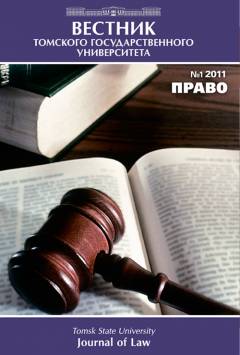Disclosure of a crime as a vector of its optimum investigation
The obtaining of factual operative information and its use in proving a criminal case represent a real vector of development of interconnected operational-searching activity and criminal procedure in the course of crime disclosure at the preliminary investigation stage. Disclosure of a crime can be understood as a cognitive process that develops from the detection of separate elements of a crime to ascertainment of its inherent legally important facts. Being transformed into the form of evidence, traces of a crime become the investigative means. The situational analysis of the practice of detection and investigation of crimes shows that a searching-cognitive activity of investigators and operating officers can develop in different ways though they both pursue the same objective -ascertainment of the truth in a criminal case. The very notion “disclosure of a crime” is evaluated by investigators differently. In criminal procedural activity of investigators to disclose a crime means to prove, first of all, the existence of a crime and then to collect evidence supporting the fact of commission of the crime by a definite person. Therefore, while defining the criminal procedural essence of the notion “disclosure of a crime” it is necessary to take into account the provisions of criminal law and the theory of evidence. Then, being the result of proof, disclosure will cover the ascertainment of all the elements of a crime to be proved. And this is the essence of disclosure of a crime”. Disclosure of a crime is a criminalistical and operational-searching category which determines the vector of optimum investigation of a crime. As compared with the criminal procedural activity the operational-searching one has an accompanying and supporting character. The use of forces and means of operational-searching activity for quick and full disclosure and investigation of a crime is a necessary condition. In a criminalistical aspect disclosure of a crime is an optional tactical task to find a person who committed a crime. That is why the notion “disclosure” is used in relation to crimes committed in the conditions of non- obviousness, i.e. when the persons who committed the crime were unidentified when the action was instituted. The results of operational-searching adivity can be used for the preparation and realization of investigative and dud adions, for the dndud of other operational-searching measures, they serve as a reason for institution of a case and for proof in diminal cases. If there are violations or departures from legislative ads regulating the grounds for operational-searching measures, the results of su^ measures cannot be used in the interests of diminal prcrcedure.
Keywords
раскрытие преступления, расследование преступления, оперативнорозыскная деятельность, disclosure of a crime, investigation of a crime, operational-searching activityAuthors
| Name | Organization | |
| Znikin Valery K. | Tomsk State University | koloss2@mail.ru |
References

Disclosure of a crime as a vector of its optimum investigation | Tomsk State University Journal of Law. 2014. № 2(12).